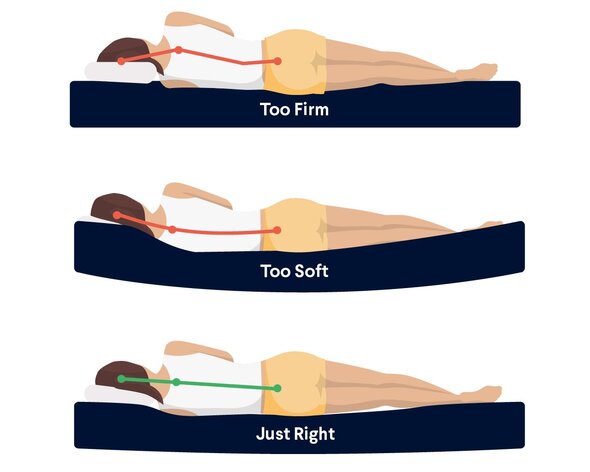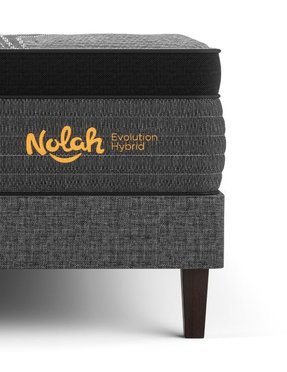What Type of Mattress Is Best for Side Sleepers?
If you're a side sleeper searching for your next mattress, you've come to the right place. Selecting a mattress based on your sleep position and body type is the best way to find a bed that truly feels fit for you, with cushioning and support in all the right places. In this guide, we'll examine the anatomy of a side sleeper and identify the ideal mattress characteristics for side snoozers like you. You'll learn what mattress firmness level best suits your needs and how to find a foam, latex, or hybrid mattress that fits the bill.
What Is a Side Sleeper?
Whether you prefer your left or right, rest with your legs curled in or extended—you’re a side sleeper if you sleep with one shoulder and hip against your mattress. An estimated 74 percent of adults sleep on their side, making it the most popular sleep position and a natural tendency for many.
Benefits of Sleeping on Your Side
Sleeping on your side can support healthy spinal alignment. According to the Sleep Foundation, it’s the position least likely to result in back pain.
Side sleeping may relieve snoring and sleep apnea, as gravity works in your favor for open airways. Your tongue falls to the side, not toward the back of your throat, which can worsen symptoms for back sleepers.
Again, thanks to gravity, side sleeping may help prevent acid reflux. Sleeping on your left side specifically may also assist digestion and waste removal.
Common Pain Points for Side Sleepers
On a mattress that’s too soft, a side sleeper’s hip may sink too far into the mattress, pulling the spine out of line.
If a side sleeper’s mattress is too firm, they may feel stiffness and pain around pressure points.
Some side sleepers may experience discomfort from stacking one knee on top of the other.
Side sleepers need the right pillow to prevent neck strain.
What Mattress Qualities Should Side Sleepers Look For?
With these benefits and vulnerabilities in mind, look for the following features in your ideal side sleeper mattress:
Gentle Contouring and Responsiveness
Side sleepers need gentle contouring to cradle and cushion the heaviest areas of their body that rest on the mattress surface: their lower shoulder, hip, and knee. A responsive mattress that flexes with your movements will soothe these areas and give you the freedom to adjust positions with ease.
Pressure Relief
Sleeping on your side concentrates your body weight on less surface area than resting on your back or stomach. To avoid soreness and pain around your joints, look for a pressure-relieving mattress that redistributes your weight and takes tension off these sensitive areas.
Spinal Support
Your back may not contact your mattress when you sleep on your side, but you still rely on your bed for spinal support and alignment while you snooze. Side sleepers need a mattress that doesn’t sink too deep at the hips, which can cause the spine to curve uncomfortably. As we’ll discuss next, choosing the right mattress firmness level for your body type is essential for keeping your spine straight as you sleep.
Cooling
While not specific to side sleepers, cooling is an essential feature to look for in your next bed if you tend to sleep hot. Seek breathable materials and cooling technology like heat-dissipating covers and foams.
What Mattress Firmness Level Is Best for Side Sleepers?
Soft to medium-firm mattresses typically offer balanced cushioning and support, comforting side sleepers while keeping the spine properly aligned. However, the exact firmness level that will work best for you also depends on how much you weigh.
Side sleepers need a sleep surface with enough give and contouring to cradle their shoulders and hips but enough resistance to prevent sinkage and misalignment. Depending on your weight, you'll likely find this balance with a mattress rated from 4 to 7 on the mattress firmness scale. See our Mattress Firmness Guide to learn more.

What Mattress Type Is Best for Side Sleepers?
As long as the mattress meets the criteria above, you can choose any mattress type that suits your preferences and budget. Here’s a closer look at the most common mattress types and how they perform for side sleepers. All are available in a range of firmness levels.
Foam Mattresses
Foam mattresses hug your curves, adjust to your movements, and redistribute your body weight—exactly what side sleepers need for night-long comfort. They also offer excellent motion isolation, a key feature for couples. If you opt for an all-foam mattress, look for one with deep, high-density layers for ample support and spinal alignment.
Latex Mattresses
Side sleepers looking for an eco-friendly option will find comfort in a latex mattress. Natural latex is highly responsive and great for side sleepers who want maximum flexibility and pressure relief.
Hybrid Mattresses
Hybrid mattresses feature foam comfort layers and a coil support core underneath, providing the balanced cushioning and deep support that side sleepers love. Their multi-layer construction also makes hybrid mattresses highly durable and well-suited for all body types. If you’re a side sleeper looking for a mattress with enhanced edge support, you’ll enjoy the added structure that a hybrid coil system provides.
Innerspring Mattresses
Traditional innerspring mattresses often lack the cushioning and contouring that side sleepers require for comfortable sleep and joint pain relief. If you’re a side sleeper who wants the structure, depth, and durability of coils, we recommend a modern hybrid mattress over a traditional innerspring option.
Nolah Picks for Side Sleeper Comfort
At Nolah, we specialize in side sleep comfort. Technology like our proprietary AirFoam™ and HDMax™ Tri-Zone™ coils are specifically designed for side sleepers, resulting in supportive mattresses that feel custom made. See our top pick below for each mattress type and sleep preference.
The Best Foam Mattress for Side Sleepers
Side sleepers looking for an all-foam option will enjoy the Nolah Signature’s plush feel and soothing pressure relief. It features Zoned AirFoam™, which is perforated around the shoulders for maximum flexibility but firmer at the hips to prevent sinkage. This premium mattress is 12.5 inches tall with four foam layers, providing deep support for spinal alignment.
The Best Hybrid Mattress for Side Sleepers
The Nolah Evolution is our deluxe hybrid mattress with seven luxurious layers. It boasts a heat-dissipating Organic Cotton + ArcticTex™ Fiber cover, a plush Euro topper, Zoned AirFoam™ HD, and HDMax™ Tri-Zone™ coils with targeted support for side sleepers. Choose from three firmness level options (Plush, Luxury Firm, and Firm) to best suit your body type and contouring preferences.
The Best Plus-Size Mattress for Side Sleepers
Our plus-size mattress provides maximum support and durability without sacrificing cushioning comfort. Enjoy plush contouring from the Euro topper, pressure relief from responsive foam layers, and spine-aligning support from the 8-inch coil system. The Nolah Evolution Comfort+ also sleeps refreshingly cool thanks to its heat-dissipating cover, breathable foams, and heat-escape border gusset.
The Best Natural Mattress for Side Sleepers
Our latex hybrid mattress, the Nolah Natural, is good for side sleepers and the environment. It uses responsive, breathable, and highly durable natural latex for the foam comfort layers and recycled steel for the coil support core.
Additional Tips for Side Sleep Comfort
With proper spinal support and pressure relief from your mattress, you’ll find restorative rest as a side sleeper. To conclude our guide, we’ll leave you with a few final tips for making this sleep position as comfortable as possible.
Choose the Right Pillow Height– When you sleep on your side, you need the appropriate pillow to counteract gravity and support your head to prevent neck strain. The best pillow for side sleepers is typically 4 to 6 inches tall with ample pressure relief.
Sleep With a Pillow Between Your Knees– If sleeping on your side agitates your knees, try placing a pillow between them to prevent contact. This can also help promote spinal alignment by preventing hip rotation.
Disclaimer: Nolah does not provide medical advice. All resources on the Nolah blog, including this article, are informational only and do not replace professional medical counsel. Talk to your doctor about any health, mental health, or sleep-related issues.
You May Also Like These Articles
Don't Sleep on Exclusive Offers
Sign up for our newsletter, and you'll be the first to know about discounts, deals, and what's new at Nolah.
Ready for Bed?
